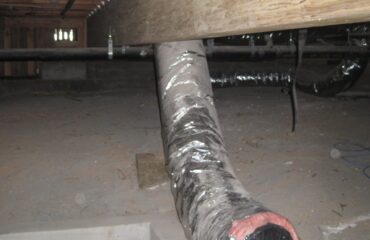Testing EMF and Magnetic Fields on BART
I have seen blogs and articles on the increase in RF (Radio Frequency) radiation in public places, especially Public Transportation, due to the ubiquity of Wi-fi and personal devices containing transmitters such as smart phones & tablets. However, I have not seen any information on the low frequency magnetic fields that may be emitted on electric trains. As a resident of the San Francisco Bay Area, the obvious candidate would be testing EMF on the BART (Bay Area Rapid Transit) Electric Commuter Rail system.
The BART system began in 1972 and currently has 44 Stations in 4 Counties, covering 104 Miles and carries over 390,000 passengers on an average weekday.
Testing EMF is something I do at least once a week. I was curious to see, anecdotally, what type of magnetic field radiation exposure was being experienced by this largely unknowing commuter population.
DISLAIMER: This is far from a scientific study. My observations and measurements are a single sample and this information is anecdotal at best. My goal is to increase awareness, stimulate discussion, and perhaps motivate a properly designed study of the actual EMF exposure experienced by passengers on the BART and other electric commuter rail systems.
On October 30, 2013 I took my Tenmars TM-192D Triaxial Magnetic Field Meter to the Lafayette, California BART Station to measure low frequency magnetic fields at the station and on the train. Testing EMF this way is fairly common.

EMF and MF (magnetic field) reading on BART platform
On the station platform, with no train near the station, the overall background MF (Magnetic Field) measured quite low, similar to general background levels, at 0.30 mG (MilliGauss).
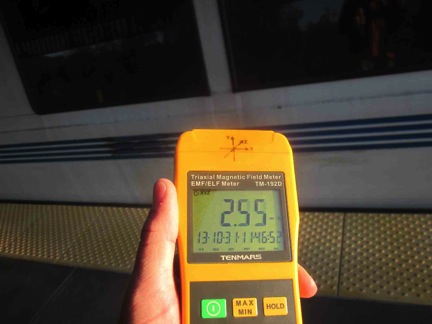
Testing EMF and MF (magnetic field) – on platform as train arrived at the station
As the train arrived at the station, the MF measurement increased to 2.55 mG.
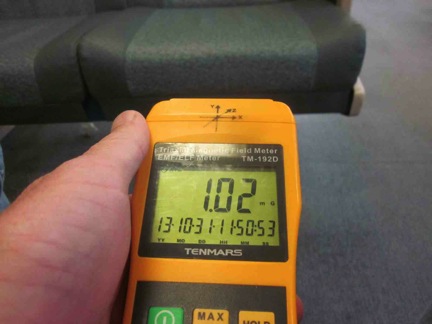
EMF and MF (magnetic field) reading – seated on BART with train stopped
I entered the train and took a seat in the middle of the car. With the train stopped at the station, with me seated in the train, the MF measured 1.02 mG.

EMF and MF (magnetic field) reading – on train as BART accelerates
As the train started accelerating the MF measurement increased almost instantly to 17.72 mG.
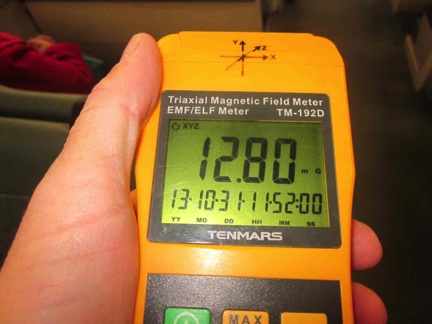
Testing EMF and MF (magnetic field) reading – as BART reaches steady speed
Testing EMF as the train reached a steady speed, I realized the magnetic field measurements settled down to 12.8 mG.
As I passed through several stops, the measurements were quite consistent, highest during accelerating and braking (due to dynamic braking, I presume), dropping to around 12 mG when at steady speed, and less than 2 mG with the train stopped.

EMF and MF (magnetic field) reading – on train as BART runs along route
As I went along I measured the MF on the floor (nearer the electric motors) and the reading was much higher at 92.90 mG.
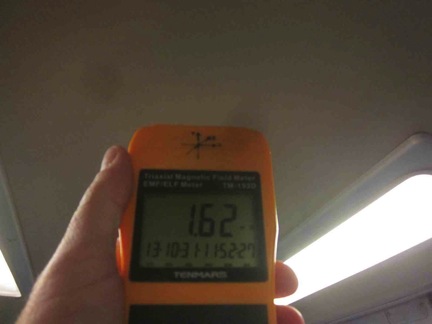
EMF and MF (magnetic field) reading – on ceiling as BART runs along route
As magnetic fields typically reduce quickly with distance from the source, I also measured the MF near the ceiling of the car and found the reading to be 1.62 mG.
After taking these measurements I did some research on the BART system. BART operates on a third rail electrical system that provides the rolling stock with 1,000 volt DC power. Typically, we are not as concerned with DC, or static, magnetic fields. After all, the earth itself is a giant DC electromagnet, with the magnetic field protecting us from harmful cosmic rays and also giving us the Northern Lights! Humans have had millions of years of evolution to get used to DC magnetic fields. Alternating Current magnetic fields, on the other hand, have only been around for 150 years or so, and we are still very much in the dark as to the actual effects of this type of radiation.
So why are the AC magnetic fields measured so high on the BART trains?
BART trains originally used DC traction motors, but the newer Rohr cars were rebuilt with ADtranz model 1507C 3-phase Alternating Current (AC) traction motors with insulated-gate bipolar transistor (IGBT) inverters, both of which emit AC magnetic fields proportionate with the amount of current running through the motors and inverters.
So although the supply current is DC, the use of inverters and AC traction motors emits significant AC magnetic fields, especially when accelerating and braking, as the trains use dynamic breaking where the motors generate electricity while braking and emit high MF during that process, due to the large amount of current (amperage) needed to power these trains.
EMF Testing Summary of Results
To reiterate all of my measurements:
|
Empty Platform |
0.30 mG |
|
Platform with train arriving |
2.55 mG |
|
Inside train, train stopped |
1.02 mG |
|
Train accelerating |
17.72 mG |
|
Train at steady, full speed, on seat |
12.80 mG |
|
Train at steady, full speed, on floor |
92.90 mG |
|
Train at steady, full speed, at ceiling |
1.62 mG |
So what do these levels mean? As with all radiation, exposure is based on exposure time and field strength. I would estimate the average BART commuter is on a train for between 1-2 hours per day, with the longest commutes being up to 4 hours per day. Train operators obviously have the highest exposure.
IBE (Institute of Biological Engineering) Sleeping Area Concern Levels in milliGauss, mG.
| None | <0.2 mG |
| Slight | 0.2 – 1.0 mG |
| Severe | 1.0 – 5.0 mG |
| Extreme | >5.0 mG |
For non-sleeping areas, levels of less than 2.0 mG are usually considered acceptable by most building biologists, although many prefer to keep long term exposure under 1.0 mG.
For a complete overview of published health-related effects from exposure to all types of electromagnetic radiation, I suggest the BioIniative Report, which is available for $2 online. www.bioinitiative.org
There are thousands of peer-reviewed, published studies demonstrating physiological responses to low-frequency EMF (electric and magnetic) and higher-frequency radiation (RF EMR). I suggest the following resources if you are interested in learning more about the health effects from artificial electro-smog. If you have health related questions speak to your physician.
http://www.bioinitiative.org/report/index.htm
Let us know if your home or workplace could benefit from Testing EMF.


